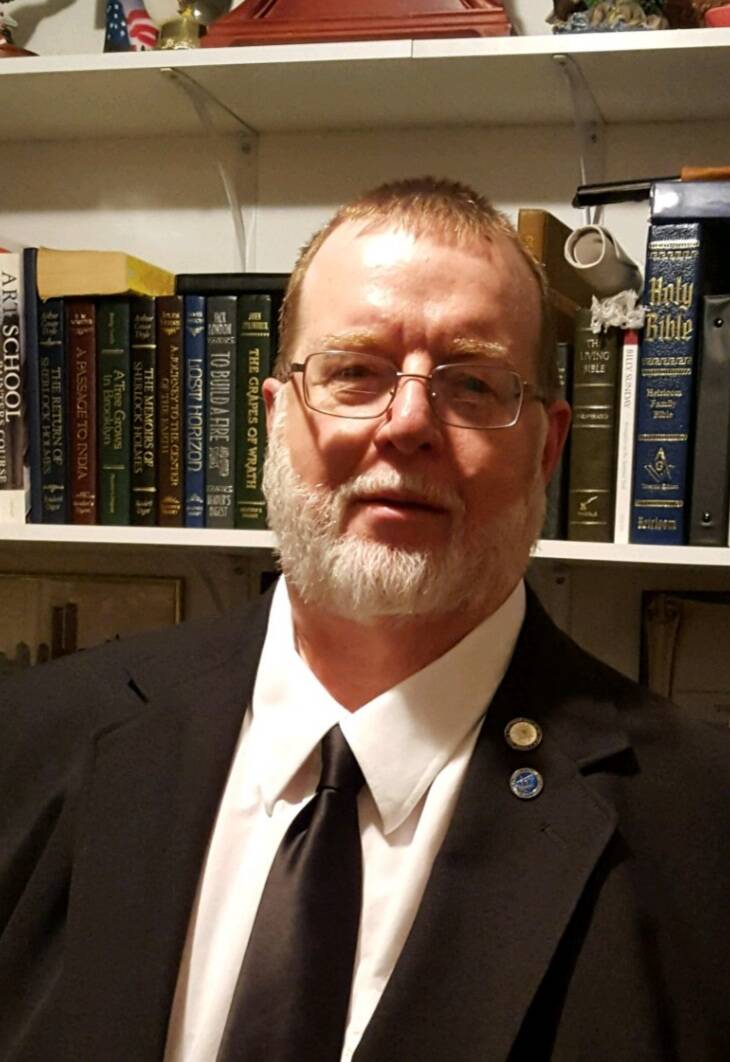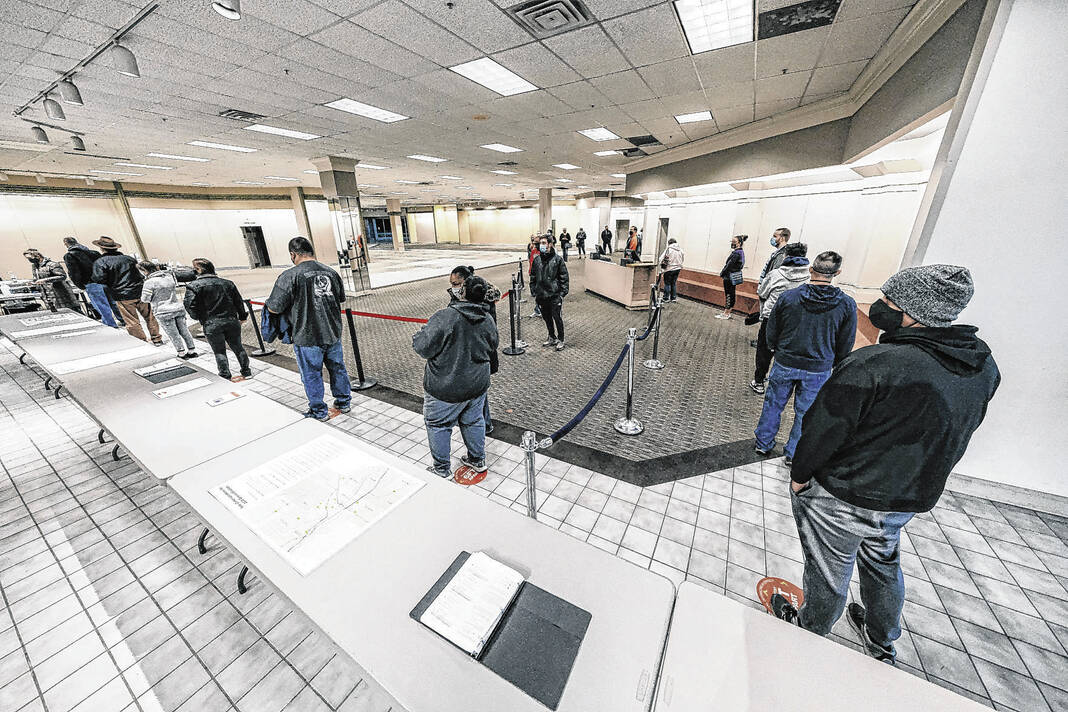Several decades after it disappeared, a grave marker for a Civil War veteran has been placed back above the final resting place in Columbus of the former Union soldier.
A construction supervisor found the headstone May 23 while moving materials north of the intersection of 10th and Maple streets, where the Golden Foundry once stood.
While preparing the grounds for what will become Ashford Parks Apartments, Greg Drysdale of ECO Construction kicked what he assumed was a piece of limestone sticking up from the ground.
Realizing the stone was larger than he originally thought, it was unearthed and flipped. The inscription read: “Nelson Calkins, Company E, 147th Indiana Infantry.”
[sc:text-divider text-divider-title=”Story continues below gallery” ]
Since the construction site manager frequently visits historical sites, Drysdale said he knew exactly what he had found.
But the identity of Calkins, as well as how the stone came to be buried at the former foundry site, were mysteries that Drysdale set out to uncover.
So did Lori Hedrick, a secretary at the Columbus Parks and Recreation Department, who helped Drysdale track down a number of public records.
One of the first things they learned was that Calkins’ marker wasn’t the first of its kind to be found at the site. A similar memorial was discovered 17 years ago, which resulted in an investigation that confirmed the land was not a former public or private cemetery, Drysdale said.
Hedrick was able to confirm that the remains of both Nelson Calkins (1834-1921) and his wife, Kate Calkins (1846-1922), are buried in a marked grave at the old City Cemetery next to Donner Park, Drysdale said.
The grave is located about a block north of the old maintenance building, about three rows west of the cemetery’s main drive.
The graves.com website, combined with archived news articles and records kept at the Bartholomew County Historical Museum, eventually revealed other details regarding the man whose name was inscribed on the stone.
Who was he?
Nelson Calkins was residing in Greene County, west of Bloomington, when he joined the 147th Indiana Infantry on Feb. 13, 1865, as a 31-year-old musician, museum manager Cody Harbaugh said after consulting records.
Although the Civil War ended before the 147th Indiana Infantry saw combat, Calkins’ unit still lost 44 enlisted men to disease over six months time before disbanding Aug. 4, 1865, Harbaugh said.
In the Jan. 28, 1891, edition of The Evening Republican, forerunner to The Republic, a news article stated that despite having served only six months, Nelson Calkins was entitled to a standard military pension. He was 57 at the time.
But six weeks later, another article with the headline “Mayor’s Court” appeared on Page 4 of the newspaper.
March 11, 1891 _ Nelson Calkins got so drunk yesterday afternoon that it required the police to take care of him. He was found guilty by Mayor (W.W.) Stader this morning, and his fine and costs fixed at the usual amount, $12.
The couple, as well as most of their children, reestablished themselves in Indianapolis before Nelson Calkins died at the age of 87.
Why the foundry site?
No one may ever know for certain how the grave marker made its way to the old foundry site, but there are theories.
For example, vandals overturned dozens of headstones in the old cemetery over a period of several weeks, according to the Jan. 26, 1949, edition of The Evening Republican.
After talking with Hedrick, Drysdale said it’s possible someone may have taken the marker at that time _ or during a similar vandalism spree in July 1953 _ and later decided to dump the evidence.
While that may be the case, a more realistic theory has evolved from historical notes provided by the Bartholomew County Historical Museum.
After verifying that Calkins died one year before his wife, Harbaugh said there have been quite a few cases where military markers were gladly accepted by financially struggling widows of Civil War veterans.
However, after some widows died, the children pooled their resources and requested the marker be replaced with a conventional headstone honoring the memory of both parents, Harbaugh said.
When Kate Calkins died in 1922, Caldwell and Drake Iron Works had been in operation for 20 years on the property where the grave marker was found last month.
It was one of a number of businesses owned by Columbus entrepreneurs George W. Caldwell and Lester Drake, who also had a downtown insurance and real estate office.
However, the most successful Caldwell and Drake enterprise was a large construction company that secured contracts to build courthouses and large government buildings throughout the country.
If the Calkins children no longer had any use for the military grave marker, a decision may have been made to move the unwanted stone 10 blocks to the iron works facility, where it would be available in case Caldwell and Drake Construction needed a cornerstone or material for an ornamental exterior facade.
However, fate didn’t provide much time for early 20th century recycling in this case. Just two years after the death of Kate Calkins, the 10th Street facility was purchased by foundry founder Walter I. Golden, who would have had no use for the marker and may have had it buried on-site.
Both Drysdale and Hedrick agree that is the theory that best fits the facts.
Final respects
After checking with officials at Garland Brook Cemetery and the Veterans Administration, Hedrick learned there is no protocol regarding what should be done with the historical grave marker, she said.
Casey Ritz, director of park operations for the city, said he also had no idea what to do with the stone. However, Ritz did know what he felt was the right thing to do.
It took about two hours to clean the marker and set it south of the existing headstone early Wednesday afternoon, Ritz said.
After the marker was erected, about a dozen people bowed their heads to pay their respects as a member of the Bartholomew County Veterans Honor Guard played taps.
Drysdale, his 6-year-old son, Xavier, and Drysdale’s father-in-law, Boy Scout Troop 543 leader Earl Bontrager, were among those present.
Others in attendance included Ritz and Michael Housefield of the Veterans Association.
[sc:pullout-title pullout-title=”Calkins’ family” ][sc:pullout-text-begin]
The following are listed as family members of Nelson Calkins on the graves.com website.
Wife:
Kate Calkins (1846-1922)
Children:
Phillip L. Calkins (1860-1937)
Sarah E. Calkins Crooke (1865-1897)
Josephine Serepta Calkins Adams (1869-1947)
Frank Calkins (1871-1954)
Indiana Zelentine Calkins Sanders (1873-1934)
Mary E. Calkins Crooke (1875-1903)
Wilson Sargent Calkins (1877-1949)
Grace Alice Calkins Hutchison (1879-1947)
[sc:pullout-text-end]






